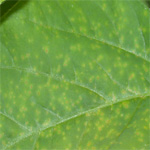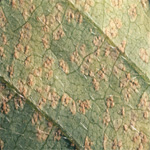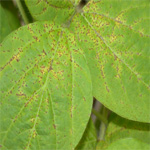Soybean Rust
Symptoms:

- Symptoms begin on the lower leaves of the plant, usually in the lower plant canopy.
- Small pustules (gray to tan or brown) surrounded by necrotic areas usually develop first on the underside of leaves on the lower part of the plant.
- Lesions can also appear on pods and stems.
- Tiny, raised pustules develop in the lesions, and the pustules break open and release tiny tan to gray spores.
Pathogen Involved:
- Two species of rust fungi cause soybean rust. Phakopsora pachyrhizi (aggressive Asian pathogen) and P. meibomiae (mild pathogen).
- Only P. pachyrhizi causes significant yield losses. Both cause the same symptoms, and they can be distinguished only with specialized laboratory tests.
- These fungi are obligate pathogens that survive only on green, living host plant tissue, and are readily dispersed long distances by wind.
Time of Occurrence:
- Can occur at all stages of soybean development, but is most common in or after the middle of the growing season.
Conditions Favoring Disease:
- Extended periods of moderate temperatures (59°F to 85°F), wet weather, leaf wetness, and high humidity (over 75%).
Disease Management:
- Scout soybean lower canopy weekly. Soybean rust can be managed with the judicious use of fungicides that must be applied properly and at the correct time.

